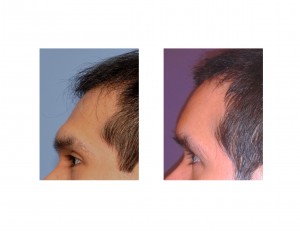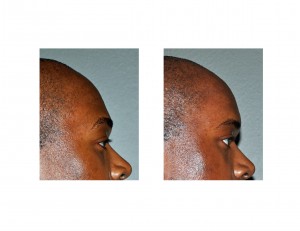The forehead occupies a major part of one’s appearance, comprising the entire upper third of the face. The variable part of anyone’s forehead is the hairline, particularly in men. Most male foreheads get longer with age for the obvious reason of a receding hairline. The relative constant features of the forehead that are easily discernible are the eyebrows and the shape of the underlying brow bones. There is also the intervening territory of the skin and the natural contour of the frontal bone between the hairline and the brows, even though it is frequently overlooked.
While the forehead may seem to many an irrelevant facial feature, there are well known differences in forehead shapes between women and men. Like the jawline, the forehead is a significant structural feature of gender. The male forehead has more of a sloped appearance in profile with the edge of the frontal hairline being more protrusive to the eyebrows in profile. It may also have more of a square shape in the front view. Men will have more prominent brow ridges with a brow break point above the eyebrows before the forehead slopes backward. Women usually have no brow ridges and lack a backward slope. The female forehead has more of a vertical inclination with a rounded or convex shape.

Besides the all important scalp scar issue in male forehead augmentation is the choice of augmentation material. There are four implantable forehead materials to be considered. By far the most common is methylmethacrylate or PMMA. A self-curing plastic polymer, it is mixed during surgery as a liquid and powder and molded into shape and allowed to set. Its popularity is due its low associated cost in an area of craniofacial augmentation in which often at least 60 or more grams of material is needed. It is the easiest cranioplasty material to shape and becomes as hard as bone. Another material option is hydroxyapatite (HA), a synthetic ceramic material. It is also a liquid and powder composite that is used like PMMA during surgery. It is slightly harder to work with and good experience is needed when using it as an onlay augmentation material. But it is the ultimate biocompatible augmentation material because it is composed of the inorganic component of natural bone, calcium phosphate. Its high cost limits it use in large augmentations for some patients.
There are also a few preformed forehead augmentation implant s available as an off-the-shelf option. But their sizes and shapes are very limited and I find them completely impractical for the unique forehead aesthetic needs for most patients that I see. The last option is to prefabricate a custom forehead implant. This requires a 3-D model made from a CT scan from which a mold is hand fashioned. It is then sent for manufacture in either silicone or a special form of PMMA known as HTR polymer. HTR is a sintered bead implant that is comprised of PMMA coated with pHEMA, a very hydrophilic material. This gives it unique properties of tissue ingrowth. The HTR polymer material is preferred over silicone as it is not only porous to allow fibrovascular ingrowth but has a long history in skull reconstructions in over 100,000 cases for the past 20 years with an incredibly low rate of implant complications.

Dr. Barry Eppley
Indianapolis, Indiana


